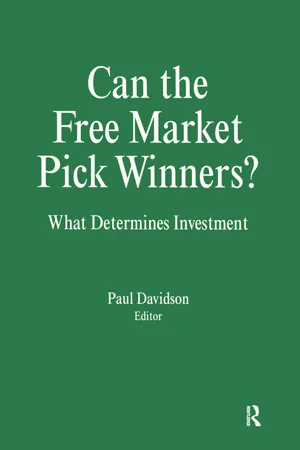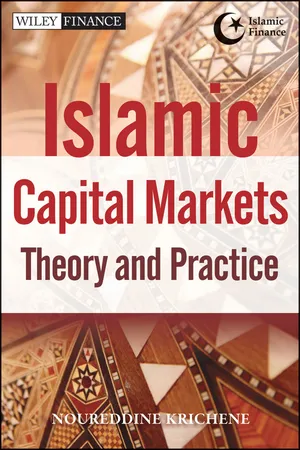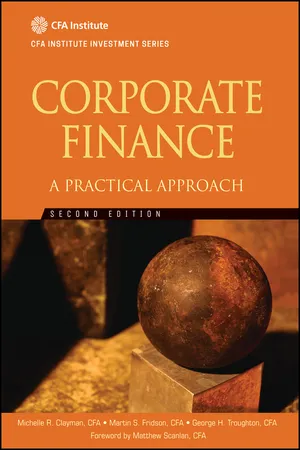Economics
User Cost of Capital
The user cost of capital refers to the total cost incurred by a firm or individual when using their own funds to finance an investment, taking into account the opportunity cost of using those funds. It includes both explicit costs, such as interest payments, and implicit costs, such as the foregone returns from alternative investments.
Written by Perlego with AI-assistance
Related key terms
3 Key excerpts on "User Cost of Capital"
- eBook - ePub
Can the Free Market Pick Winners?
What Determines Investment
- Paul Davidson(Author)
- 2016(Publication Date)
- Routledge(Publisher)
8The user cost of fixed capital in Keynes’ theory of investment JOHAN DEPREZ“It is by reason,” wrote Keynes, “of the existence of durable equipment that the economic future is linked to the present” (1964, p. 146). It was Keynes’ opinion that by “the introduction of the concepts of user cost and of the marginal efficiency of capital” one could go beyond the limits of the static nature of classical economics and effectively model the intertemporal aspects of fixed capital and the expectations that surround it “whilst reducing to a minimum the necessary degree of adaption” from the classical theory (1964, p. 146).User cost is the opportunity cost of currently engaging in production and the using of plant and equipment, as opposed to currently abstaining from production and leaving the fixed capital idle, measured in terms of the expected loss of discounted future profits. Such cost may be expected if current production negatively affects the future productivity of capital, increases the required replacement of capital equipment, negatively affects future expected sales, or increases the cost of future inputs. In the real world where firms face an uncertain future in terms of sales, costs, technological change, and new products, user cost is a pervasive consideration affecting the production and investment decisions of firms.The emphasis in the literature has generally been on the concept of the marginal efficiency of capital to the neglect of the concept of user cost. This is the way in which Keynes’ model is characterized by most textbooks (see Peterson and Estenson, 1992, pp. 303–320). Traditional expositions of Keynes’ General Theory,1 like Hansen’s (1953, pp. 56–58), have trivialized the role of user cost. Post Keynesian expositions of Keynes’ aggregate supply and demand model have tended to ignore the concept completely (see Weintraub, 1957; Davidson and Smolensky, 1964; Wells, 1977)2 - eBook - ePub
Islamic Capital Markets
Theory and Practice
- Noureddine Krichene(Author)
- 2012(Publication Date)
- Wiley(Publisher)
market refers to the universe of investors who are reasonable candidates to provide funds for a particular investment. Capital or funds are usually provided in the form of cash, although in some instances capital may be provided in form of other assets. The cost of capital usually is expressed in percentage terms—that is, the annual amount of dollars that investors require or expect to realize, expressed as a percentage of the dollar amount invested. It applies to a company, security, or project in which we are interested.Since the cost of anything can be defined as the price one must pay to get it, the cost of capital is the return a company must promise in order to get capital from the market, either debt or equity. A company does not set its own cost of capital; it must go to the market to discover it. Yet meeting this cost is the financial market’s one basic yardstick for determining whether a company’s performance is adequate. The cost of capital is always an expected or forward-looking return. The opportunity cost of capital is equal to the return that could have been earned on alternative investments at a specific level of risk. In other words, it is the competitive return available in the market on a comparable investment, with risk being the most important component of comparability.The cost of capital depends on the components of a company’s capital structure. The primary components of a capital structure include:- Debt capital
- Preferred equity
- Common equity
Each component of an entity’s capital structure has its unique cost, depending primarily on its respective risk. The cost of capital can be viewed from three different perspectives. On the asset side of a firm’s balance sheet, it is the rate that should be used to discount to a present value the future expected cash flows. On the liability side, it is the economic cost to the firm of attracting and retaining capital in a competitive environment, in which investors (capital providers) carefully analyze and compare all return-generating opportunities. On the investor’s side, it is the return one expects and requires from an investment in a firm’s debt or equity. While each of these perspectives might view the cost of capital differently, they are all dealing with the same number. - eBook - ePub
Corporate Finance
A Practical Approach
- Michelle R. Clayman, Martin S. Fridson, George H. Troughton(Authors)
- 2012(Publication Date)
- Wiley(Publisher)
Cost of capital estimation is a challenging task. As we have already implied, the cost of capital is not observable but, rather, must be estimated. Arriving at a cost of capital estimate requires a host of assumptions and estimates. Another challenge is that the cost of capital that is appropriately applied to a specific investment depends on the characteristics of that investment: The riskier the investment’s cash flows, the greater its cost of capital. In reality, a company must estimate project-specific costs of capital. What is often done, however, is to estimate the cost of capital for the company as a whole and then adjust this overall corporate cost of capital upward or downward to reflect the risk of the contemplated project relative to the company’s average project.This chapter is organized as follows: In the next section, we introduce the cost of capital and its basic computation. Section 3 presents a selection of methods for estimating the costs of the various sources of capital, and Section 4 discusses issues an analyst faces in using the cost of capital. Section 5 summarizes the chapter.2. COST OF CAPITALThe cost of capital is the rate of return that the suppliers of capital—bondholders and owners—require as compensation for their contribution of capital. Another way of looking at the cost of capital is that it is the opportunity cost of funds for the suppliers of capital: A potential supplier of capital will not voluntarily invest in a company unless its return meets or exceeds what the supplier could earn elsewhere in an investment of comparable risk.A company typically has several alternatives for raising capital, including issuing equity, debt, and instruments that share characteristics of debt and equity. Each source selected becomes a component of the company’s funding and has a cost (required rate of return) that may be called a component cost of capital. Because we are using the cost of capital in the evaluation of investment opportunities, we are dealing with a marginal
Index pages curate the most relevant extracts from our library of academic textbooks. They’ve been created using an in-house natural language model (NLM), each adding context and meaning to key research topics.


